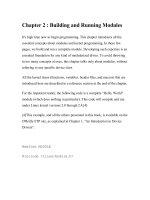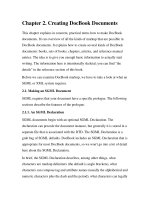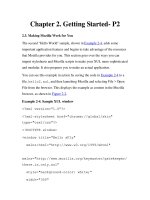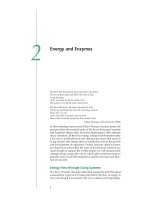Chapter 2: Data and Expressions pptx
Bạn đang xem bản rút gọn của tài liệu. Xem và tải ngay bản đầy đủ của tài liệu tại đây (375.98 KB, 49 trang )
Chapter 2
Data and
Expressions
Data and Expressions
•
Let's explore some other fundamental programming
concepts
•
Chapter 2 focuses on:
character strings
primitive data
the declaration and use of variables
expressions and operator precedence
data conversions
accepting input from the user
Java applets
introduction to graphics
© 2004 Pearson Addison-Wesley. All rights reserved
2-2
Outline
Character Strings
Variables and Assignment
Primitive Data Types
Expressions
Data Conversion
Interactive Programs
Graphics
Applets
Drawing Shapes
© 2004 Pearson Addison-Wesley. All rights reserved
2-3
Character Strings
•
A string of characters can be represented as a
string literal by putting double quotes around
the text:
•
Examples:
"This is a string literal."
"123 Main Street"
"X"
•
Every character string is an object in Java,
defined by the String class
ã
Every string literal represents a String object
â 2004 Pearson Addison-Wesley. All rights reserved
2-4
The println Method
•
In the Lincoln program from Chapter 1, we
invoked the println method to print a character
string
•
The System.out object represents a destination
(the monitor screen) to which we can send output
System.out.println ("Whatever you are, be a good one.");
object
method
information provided to the method
name
(parameters)
© 2004 Pearson Addison-Wesley. All rights reserved
2-5
The print Method
•
The System.out object provides another service
as well
•
The print method is similar to the println
method, except that it does not advance to the
next line
•
Therefore anything printed after a print
statement will appear on the same line
ã
See Countdown.java (page 63)
â 2004 Pearson Addison-Wesley. All rights reserved
2-6
String Concatenation
•
The string concatenation operator (+) is used to
append one string to the end of another
"Peanut butter " + "and jelly"
•
It can also be used to append a number to a
string
•
A string literal cannot be broken across two
lines in a program
ã
See Facts.java (page 65)
â 2004 Pearson Addison-Wesley. All rights reserved
2-7
String Concatenation
•
The + operator is also used for arithmetic
addition
•
The function that it performs depends on the
type of the information on which it operates
•
If both operands are strings, or if one is a
string and one is a number, it performs string
concatenation
•
If both operands are numeric, it adds them
•
The + operator is evaluated left to right, but
parentheses can be used to force the order
ã
See Addition.java (page 67)
â 2004 Pearson Addison-Wesley. All rights reserved
2-8
Escape Sequences
•
What if we wanted to print a the quote
character?
•
The following line would confuse the compiler
because it would interpret the second quote as
the end of the string
System.out.println ("I said "Hello" to you.");
•
An escape sequence is a series of characters
that represents a special character
•
An escape sequence begins with a backslash
character (\)
System.out.println ("I said \"Hello\" to you.");
© 2004 Pearson Addison-Wesley. All rights reserved
2-9
Escape Sequences
•
Some Java escape sequences:
Escape Sequence Meaning
\b
\t
\n
\r
\"
\'
\\
backspace
tab
newline
carriage return
double quote
single quote
backslash
• See Roses.java (page 68)
© 2004 Pearson Addison-Wesley. All rights reserved
2-10
Outline
Character Strings
Variables and Assignment
Primitive Data Types
Expressions
Data Conversion
Interactive Programs
Graphics
Applets
Drawing Shapes
© 2004 Pearson Addison-Wesley. All rights reserved
2-11
Variables
•
A variable is a name for a location in memory
•
A variable must be declared by specifying the
variable's name and the type of information that
it will hold
data type
variable name
int total;
int count, temp, result;
Multiple variables can be created in one declaration
© 2004 Pearson Addison-Wesley. All rights reserved
2-12
Variable Initialization
•
A variable can be given an initial value in the
declaration
int sum = 0;
int base = 32, max = 149;
• When a variable is referenced in a program, its
current value is used
ã See PianoKeys.java (page 70)
â 2004 Pearson Addison-Wesley. All rights reserved
2-13
Assignment
•
An assignment statement changes the value of a
variable
•
The assignment operator is the = sign
total = 55;
• The expression on the right is evaluated and the
result is stored in the variable on the left
• The value that was in total is overwritten
• You can only assign a value to a variable that is
consistent with the variable's declared type
• See Geometry.java (page 71)
© 2004 Pearson Addison-Wesley. All rights reserved
2-14
Constants
•
A constant is an identifier that is similar to a
variable except that it holds the same value
during its entire existence
•
As the name implies, it is constant, not
variable
•
The compiler will issue an error if you try to
change the value of a constant
•
In Java, we use the final modifier to declare a
constant
final int MIN_HEIGHT = 69;
© 2004 Pearson Addison-Wesley. All rights reserved
2-15
Constants
•
Constants are useful for three important reasons
•
First, they give meaning to otherwise unclear
literal values
For example, MAX_LOAD means more than the literal 250
•
Second, they facilitate program maintenance
If a constant is used in multiple places, its value need
only be updated in one place
•
Third, they formally establish that a value
should not change, avoiding inadvertent errors
by other programmers
© 2004 Pearson Addison-Wesley. All rights reserved
2-16
Outline
Character Strings
Variables and Assignment
Primitive Data Types
Expressions
Data Conversion
Interactive Programs
Graphics
Applets
Drawing Shapes
© 2004 Pearson Addison-Wesley. All rights reserved
2-17
Primitive Data
•
There are eight primitive data types in Java
•
Four of them represent integers:
byte, short, int, long
•
Two of them represent floating point numbers:
float, double
•
One of them represents characters:
char
•
And one of them represents boolean values:
boolean
© 2004 Pearson Addison-Wesley. All rights reserved
2-18
Numeric Primitive Data
•
The difference between the various numeric
primitive types is their size, and therefore the
values they can store:
Type
Storage Min Value
byte
short
int
long
8 bits
16 bits
32 bits
64 bits
127
-128
32,767
-32,768
-2,147,483,648 2,147,483,647
< -9 x 1018
> 9 x 1018
float
double
32 bits
64 bits
+/- 3.4 x 1038 with 7 significant digi
+/- 1.7 x 10308 with 15 significant di
© 2004 Pearson Addison-Wesley. All rights reserved
Max Value
2-19
Characters
•
A char variable stores a single character
•
Character literals are delimited by single
quotes:
'a'
•
'X'
'7'
'$'
','
'\n'
Example declarations:
char topGrade = 'A';
char terminator = ';', separator = ' ';
•
Note the distinction between a primitive
character variable, which holds only one
character, and a String object, which can hold
multiple characters
© 2004 Pearson Addison-Wesley. All rights reserved
2-20
Character Sets
•
A character set is an ordered list of
characters, with each character corresponding to
a unique number
•
A char variable in Java can store any character
from the Unicode character set
•
The Unicode character set uses sixteen bits per
character, allowing for 65,536 unique characters
•
It is an international character set, containing
symbols and characters from many world languages
© 2004 Pearson Addison-Wesley. All rights reserved
2-21
Characters
•
The ASCII character set is older and smaller
than Unicode, but is still quite popular
•
The ASCII characters are a subset of the Unicode
character set, including:
uppercase lettersA, B, C, …
lowercase letters a, b, c, …
punctuation
period, semi-colon, …
digits
0, 1, 2, …
special symbols &, |, \, …
control characters
carriage return, tab, ...
© 2004 Pearson Addison-Wesley. All rights reserved
2-22
Boolean
•
A boolean value represents a true or false
condition
•
The reserved words true and false are the only
valid values for a boolean type
boolean done = false;
•
A boolean variable can also be used to represent
any two states, such as a light bulb being on or
off
© 2004 Pearson Addison-Wesley. All rights reserved
2-23
Outline
Character Strings
Variables and Assignment
Primitive Data Types
Expressions
Data Conversion
Interactive Programs
Graphics
Applets
Drawing Shapes
© 2004 Pearson Addison-Wesley. All rights reserved
2-24
Expressions
•
An expression is a combination of one or more
operators and operands
•
Arithmetic expressions compute numeric results
and make use of the arithmetic operators:
Addition
Subtraction
Multiplication
Division
Remainder
+
*
/
%
• If either or both operands used by an arithmetic
operator are floating point, then the result is a
floating point
© 2004 Pearson Addison-Wesley. All rights reserved
2-25









